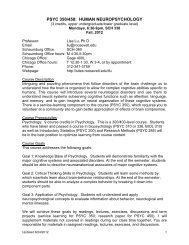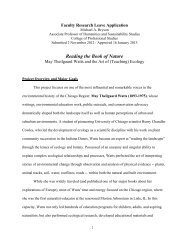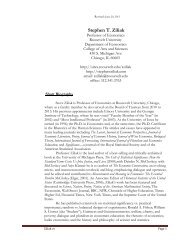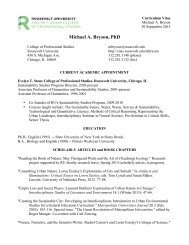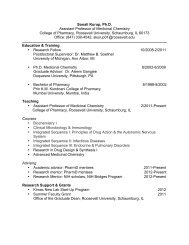Social Insurance and Public Assistance
public-assistance-welfare-reform-colonial-times-to-the-present-ziliak ...
public-assistance-welfare-reform-colonial-times-to-the-present-ziliak ...
You also want an ePaper? Increase the reach of your titles
YUMPU automatically turns print PDFs into web optimized ePapers that Google loves.
SOCIAL WELFARE: 1929 TO THE PRESENT 705<br />
TABLE Bf-D Long-term changes in key indicators for the Old-Age, Survivors <strong>Insurance</strong> program under <strong>Social</strong><br />
Security: 1940–1996<br />
Ratios to the number of<br />
workers with taxable earnings<br />
Ratio of benefits to average monthly earnings of<br />
workers in covered employment<br />
Average<br />
Retired-worker family<br />
OASI benefits earnings of Survivor family: Disabled-worker Maximum<br />
Retired-worker paid per worker workers in widowed mother family: worker, benefit payable<br />
Workers families receiving Survivor families with taxable covered Male Female or father <strong>and</strong> spouse, <strong>and</strong> to men at<br />
fully insured old-age benefits receiving benefits earnings employment worker only worker only one child one child retirement<br />
Year Ratio Ratio Ratio 1992 dollars 1992 dollars Ratio Ratio Ratio Ratio Ratio<br />
1940 0.68 0.003 0.001 9 9,382 0.27 0.22 0.40 — 0.49<br />
1950 1.24 0.036 0.010 109 12,439 0.24 0.18 0.41 — 0.24<br />
1960 1.16 0.108 0.027 633 15,712 0.26 0.20 0.43 0.61 0.39<br />
1970 1.16 0.140 0.039 1,015 18,735 0.27 0.21 0.45 0.55 0.40<br />
1980 1.24 0.169 0.041 1,541 19,492 0.38 0.30 0.63 0.74 0.58<br />
1990 1.23 0.183 0.038 1,783 21,621 0.40 0.31 0.60 0.63 0.58<br />
1996 1.22 0.184 0.035 1,913 22,618 0.40 0.31 0.59 0.60 0.60<br />
(continued)<br />
Percentage of recipients Percentage of recipients Tax rates for employer<br />
age 80 <strong>and</strong> older accepting reduced benefits <strong>and</strong> employee each<br />
Maximum<br />
OASI trust fund<br />
Male Female Male Female OASI DI HI taxable earnings assets<br />
Million 1992<br />
Year Percent Percent Percent Percent Percent Percent Percent 1992 dollars dollars<br />
1940 1.8 0.6 — — 1.00 — — 27,901 18,889<br />
1950 7.1 3.7 — — 1.50 — — 16,408 75,046<br />
1960 12.1 7.2 — 33.4 2.75 0.25 — 20,627 87,336<br />
1970 15.9 14.4 35.9 58.5 3.65 0.55 0.60 25,590 106,475<br />
1980 15.6 18.3 54.8 69.1 4.52 0.56 1.05 42,931 37,831<br />
1990 16.6 22.7 64.6 72.6 5.60 0.60 1.45 54,806 228,834<br />
1996 18.5 25.9 68.0 74.4 5.26 0.94 1.45 56,890 453,165<br />
Sources<br />
GDP deflator used to convert nominal dollars to 1992 dollars: the deflator<br />
derived from the nominal <strong>and</strong> real GDP series rounded to billions of dollars<br />
that formed the basis for tables in the Council of Economic Advisors, Economic<br />
Report of the President Transmitted to Congress February 1998 (U.S.<br />
Government Printing Office, 1998), pp. 280–2.<br />
Workers with taxable earnings: series Bf381.<br />
Workers fully insured for retirement or survivor benefits: series Bf377.<br />
Retired-worker families receiving old-age benefits: sum of series Bf408<br />
<strong>and</strong> Bf411.<br />
Survivor families receiving benefits: sum of series Bf412–415.<br />
Benefits paid: series Bf395.<br />
Average annual earnings of workers in covered employment: series Bf384<br />
divided by series Bf381. Average monthly earnings of workers in covered employment:<br />
average annual earnings divided by 12.<br />
Ratio of benefits to average earnings of workers in covered employment:<br />
series Bf462, Bf463, Bf466, Bf472, <strong>and</strong> Bf474, each expressed as a ratio to<br />
the average monthly earnings of workers in covered employment.<br />
Percentage of beneficiaries age 80 <strong>and</strong> over: series Bf431 <strong>and</strong> Bf441.<br />
Percentage of beneficiaries accepting reduced benefits: for men, series<br />
Bf425 <strong>and</strong> Bf435.<br />
Tax rates for employer <strong>and</strong> employee each: series Bf389–391.<br />
Maximum taxable earnings: series Bf386.<br />
OASI trust fund assets: series Bf451.<br />
well as increasing numbers of people accepting reduced benefits<br />
for early retirement. The average age of retired-workers beneficiaries<br />
has risen by 5 years for males <strong>and</strong> 6.4 years for females<br />
between 1940 <strong>and</strong> 1996 (series Bf426 <strong>and</strong> Bf436). Meanwhile the<br />
percentage of beneficiaries aged 80 <strong>and</strong> over in Table Bf-D has<br />
risen from below 2 percent in 1940 to over 18.5 percent for males<br />
<strong>and</strong> 25.9 percent for females in 1996. These averages <strong>and</strong> percentages<br />
understate the true rise in life expectancy because women <strong>and</strong><br />
men became eligible to draw reduced benefits at age 62 in 1956<br />
<strong>and</strong> 1961, respectively. 9 The monthly benefits are reduced to allow<br />
9 As of 1997, the reduction in OASI benefits for a person who accepted benefits<br />
between age 62 <strong>and</strong> the retirement age of 65 (rising to 67 next decade) was<br />
five ninths of 1 percent for each month of entitlement prior to age 65 up to a<br />
maximum of 20 percent.<br />
for the increased length of time that the retired worker accepts the<br />
benefits. 10 Despite these administrative reductions in benefits, the<br />
10 The SSA reports average monthly benefits for those with full benefits <strong>and</strong><br />
those with reductions for early acceptance. The ratio of average monthly benefits<br />
paid to beneficiaries with reduced benefits to average monthly benefits for those<br />
with full benefits has remained stable at around 75 percent for both men <strong>and</strong><br />
women since 1985 (see Table Bf476–483). The ratio gives the impression that<br />
people lose more from early retirement than they actually do. Through 1979, the<br />
SSA came up with a calculation of what workers who had reductions for early<br />
retirement would have received without the reduction (see Table Bf476–483).<br />
The ratios of the average reduced benefits to the average benefits they would<br />
have received without reduction were roughly 90 percent over the period. Thus,<br />
the differences between average benefits for early retirees <strong>and</strong> regular retirees is<br />
caused by difference in the lifetime labor force participation, age at retirement,<br />
<strong>and</strong> possible income differences at the time of retirement of the two groups.



